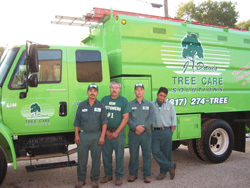
A new season brings a sense of renewal and anticipation for the locals as they expect the return of cooler weather, the changing of the leaves, and a new beginning. Yet, along with fall's splendor comes a new crop of pests that can decimate your trees.
Knowing how to recognize these pests will allow you to protect your trees from harm better. Here you can learn what to look for and how to control Arlington's most common tree pests.
Keep reading to learn how Arlington Tree Care Services can help your trees thrive this fall.
Fall Tree Pest Guide from J Davis Tree Care Solutions
Fall Webworms
Common Arlington tree pest that feed on many trees. About an inch, the larvae have silky hair covering their entire body and can be any shade of pale yellow, gray, or reddish brown with two rows of spots along the back. This fall pest is more of an aesthetic problem than a health risk for your tree.
Signs: After they hatch, fall webworms spin a flimsy silken web over the foliage they feed on. The leaves become skeletonized when the webs encase the tree's crown, branches, or plants.
Myrtle Bark Scale
A pest of North Arlington's crape myrtle trees in the fall and winter as it develops into a pupa or nymph. Because of their attractiveness and prevalence in residential and commercial landscapes, crape myrtle trees are a frequent target of this fall pest.
Signs: The felt-like encrustations of crape myrtle bark scale are a telltale sign that the tree is infested with this pest. They pop up everywhere, from tiny twigs to massive trees. Black sooty mold on tree bark is often the first symptom of crape myrtle bark scale. The liquid that seeps from the scales resembles pink blood when crushed.
Twig Girdling Beetles Need J Davis Tree Care Solutions
These pests, also known as long-horned beetles, are a yearly phenomenon that strikes from September through November.
Small branches on the ground may look freshly cut, a telltale sign. These autumn pests will gnaw a V-shaped notch about the size of a pencil into a branch. Then, they leave a frail, connected portion of the branch to the trunk.
Deodar Weevil Need Arlington Tree Care
Species of this weevil feed on the roots, lower trunks, and stumps of North Arlington's woody ornamental trees.
Weevil pupae are easily identified by their snout and legless, white bodies. They feed, molt, and develop during the year's colder months by boring under the bark. It is especially common for young trees to die after being planted in unfavorable locations.
Deodar weevils cause death by girdling tree stems, which can't always be seen because they feed beneath the bark. In addition, the bark may swell in places where the pests have made their home.
Get Help With Pest Control and Tree Care From Arlington Tree Care Experts
Protect your trees from the fall's pests and diseases with preventative tree care. Your trees will be better able to control insect populations if you keep them strong and healthy.
Consult an ISA-Certified Arborist for advice and help with heat and drought-stressed trees. Our tree specialists can provide you with a complete treatment plan to prevent and manage tree pests all year round as part of our efforts to be a sustainable, all-inclusive tree care company.
To get your tree seen and cared for, you can quickly Contact J Davis Tree Care Solutions for the best tree care solutions, or you can fill in the compact form, and the staff will be in touch.
You can check our customer reviews on BBB, Yelp, or Yellow Pages.

